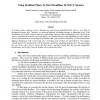Free Online Productivity Tools
i2Speak
i2Symbol
i2OCR
iTex2Img
iWeb2Print
iWeb2Shot
i2Type
iPdf2Split
iPdf2Merge
i2Bopomofo
i2Arabic
i2Style
i2Image
i2PDF
iLatex2Rtf
Sci2ools
NCA
2005
IEEE
2005
IEEE
Using Residual Times to Meet Deadlines in M/G/C Queues
In systems where customer service demands are only known probabilistically, there is very little to distinguish between jobs. Therefore, no universal optimum scheduling strategy or algorithm exists. If the distribution of job times is known, then the residual time (expected time remaining for a job), based on the service it has already received, can be calculated. In a detailed discrete event simulation, we have explored the use of this function for increasing the probability that a job will meet its deadline. We have tested many different distributions with a wide range of and shape, four of which are reported here. We compare with RR and FCFS, and find that in all distributions studied our algorithm performs best. We also studied the use of two slow servers versus one fast server, and have found that they provide comparable performance, and in a few cases the double server system does better. 2 σ
Customer Service Demands | Discrete Event Simulation | NCA 2005 | Network Computing | Universal Optimum Scheduling |
Related Content
| Added | 25 Jun 2010 |
| Updated | 25 Jun 2010 |
| Type | Conference |
| Year | 2005 |
| Where | NCA |
| Authors | Sarah Tasneem, Lester Lipsky, Reda A. Ammar, Howard A. Sholl |
Comments (0)

